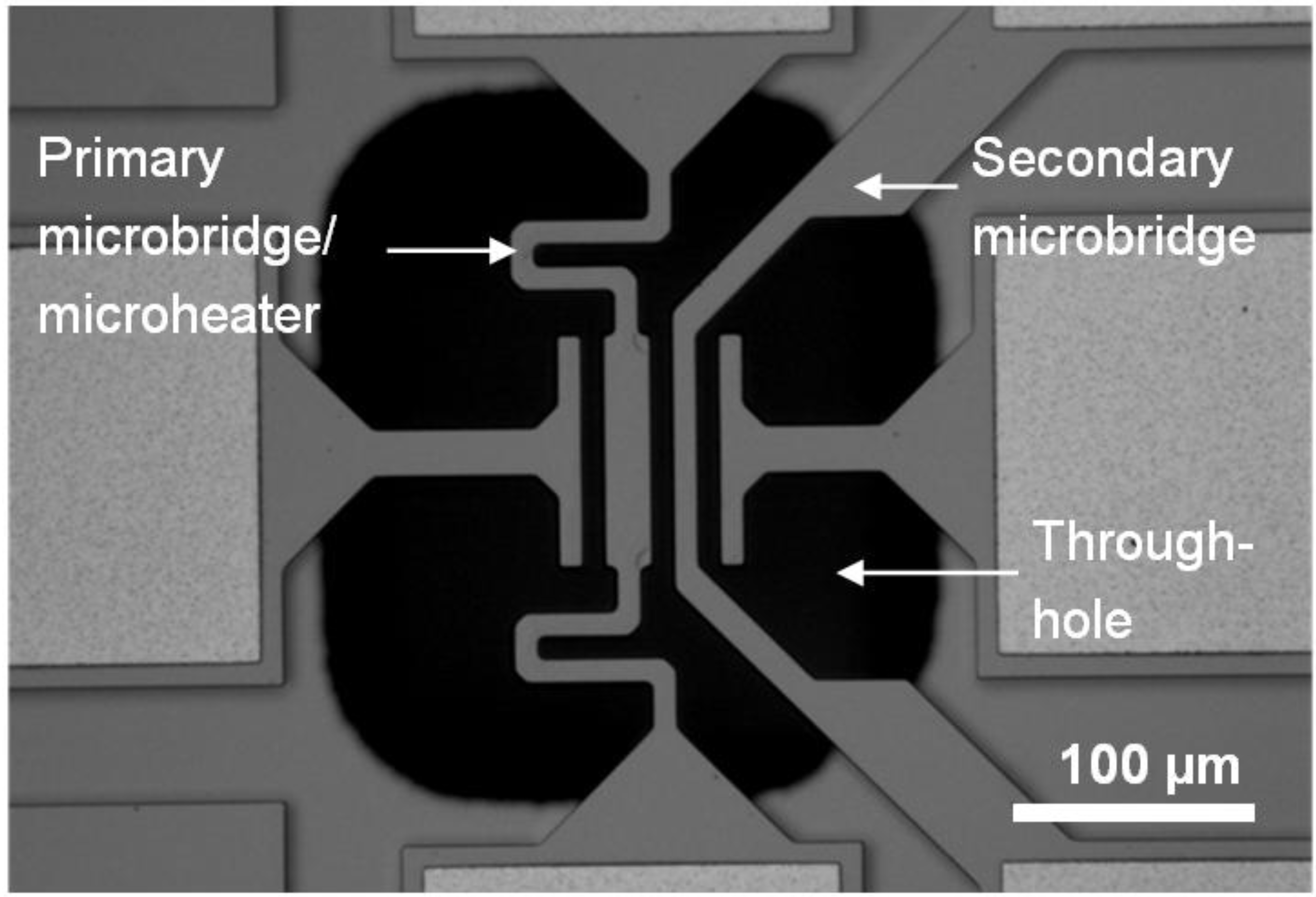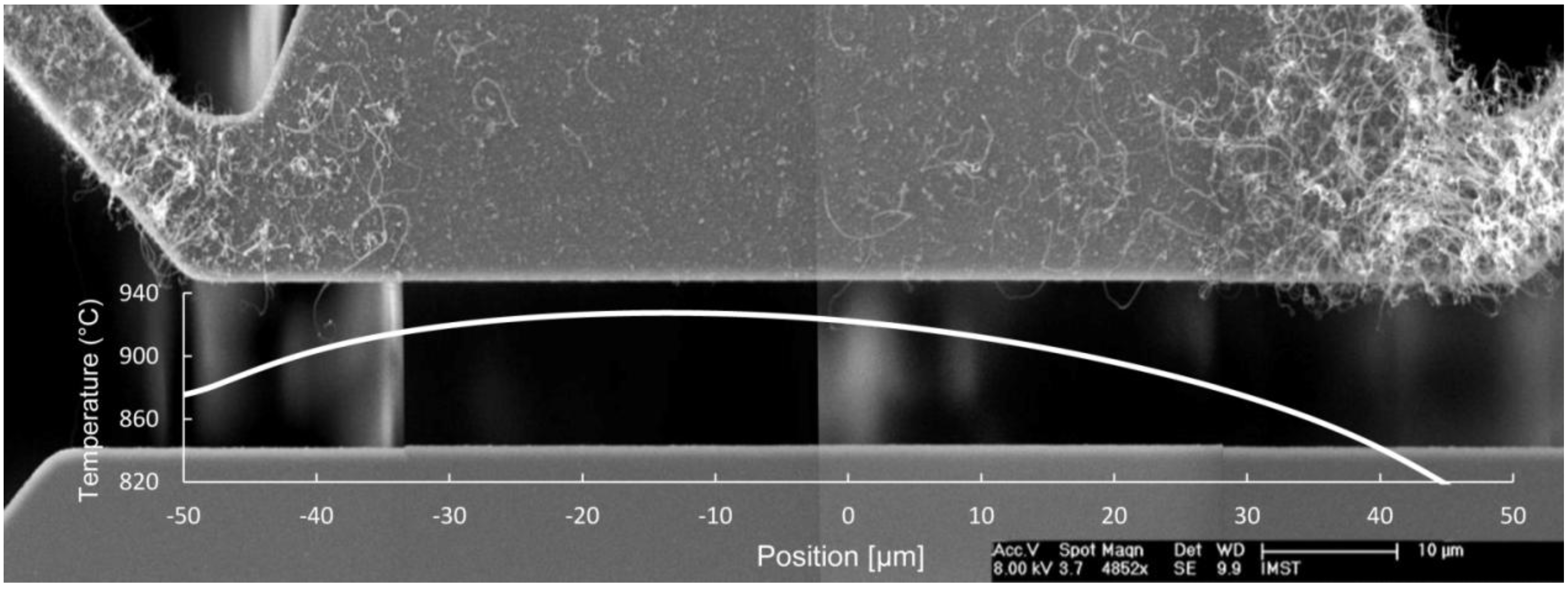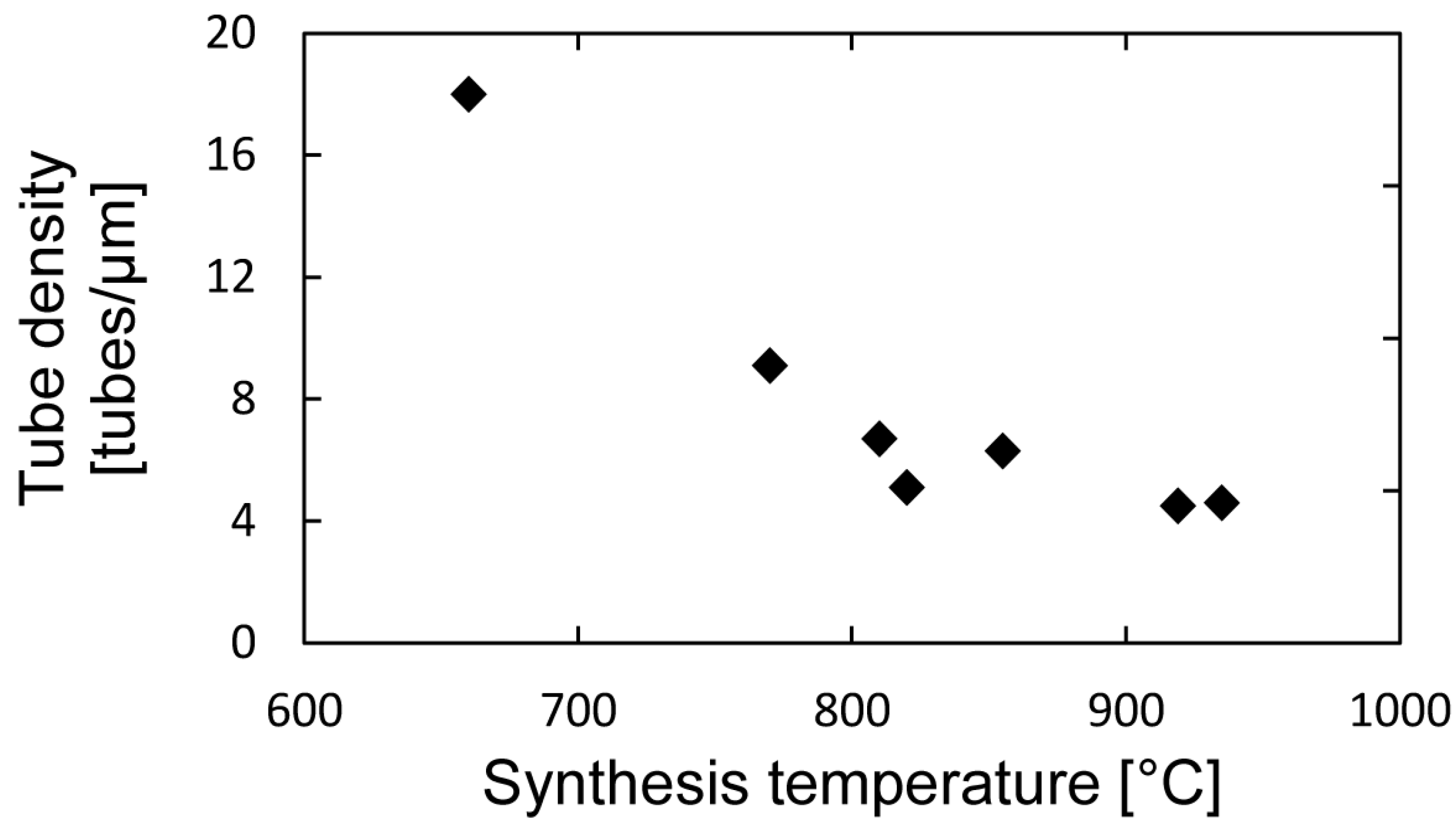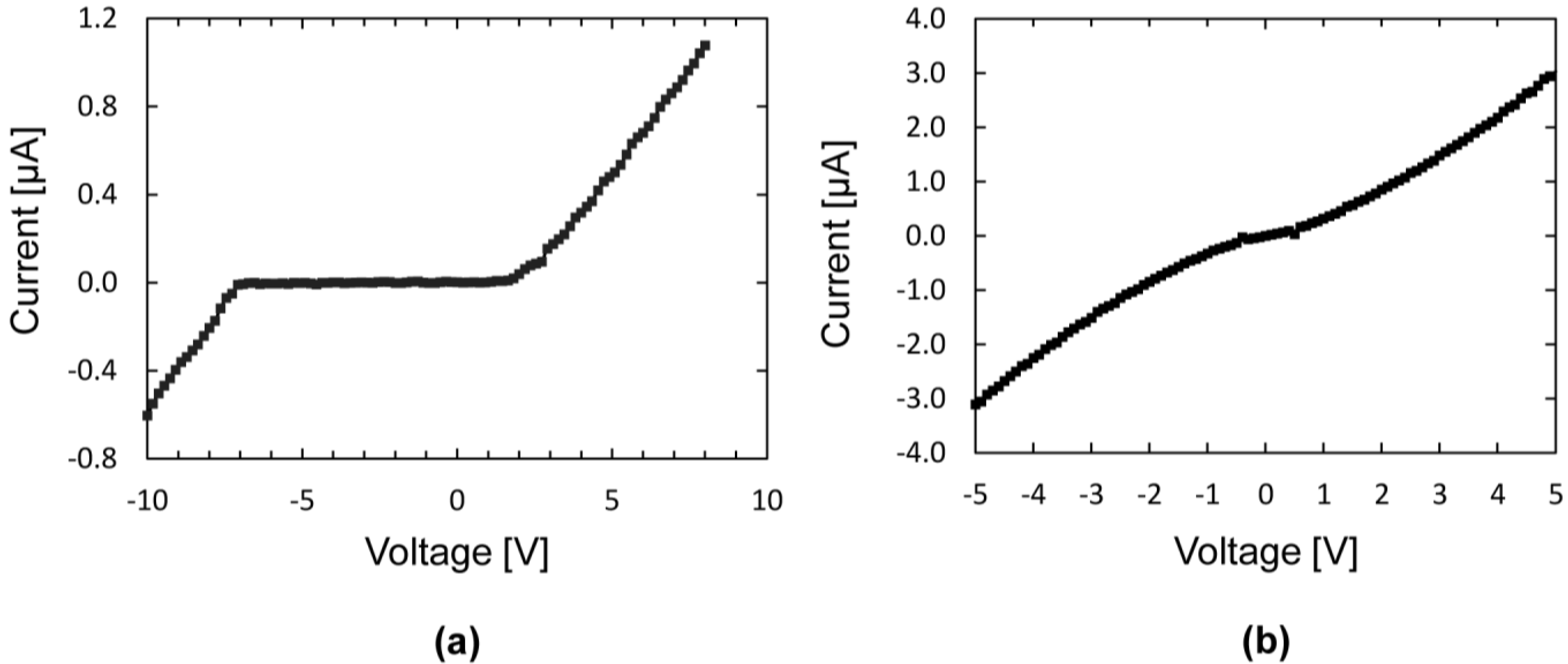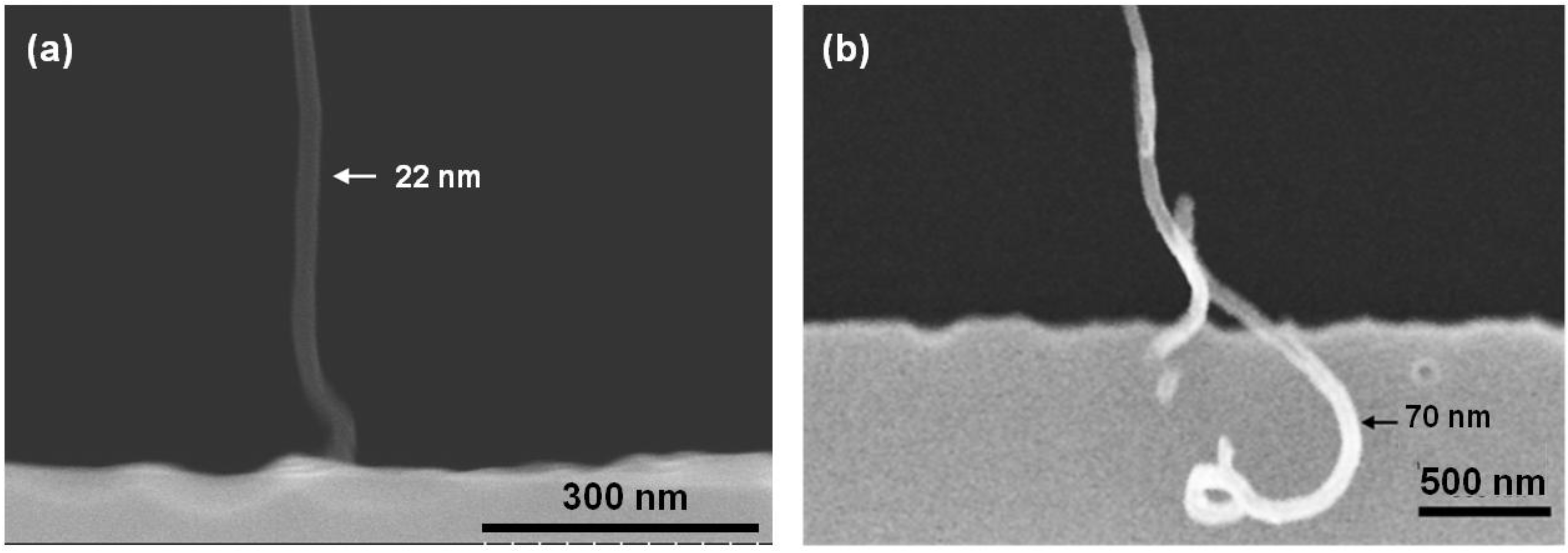3.1. Types of CNTs
Figure 2 shows an SEM image of a microheater with CNT growth on its surface. The asymmetric growth along the heater is explained by the Thomson effect, a thermoelectric effect that is observed when an electric current is passed through a conductor along which there also is a temperature gradient. The result is that the hottest point is shifted from the center of the bridge by a distance known as the Thomson shift [
21].
Figure 2.
Scanning Electron Microscope (SEM) micrograph of microheater after CNT growth with simulated temperature profile, showing the asymmetrical temperature distribution, due to the Thomson effect.
Figure 2.
Scanning Electron Microscope (SEM) micrograph of microheater after CNT growth with simulated temperature profile, showing the asymmetrical temperature distribution, due to the Thomson effect.
Figure 2 also shows the temperature profile along the microheater, obtained by FEM simulations in which the Thomson effect was included. The asymmetry in the temperature profile corresponds well to the asymmetry in the growth. The highest temperature in the simulated profile is shifted 15 µm left of the center of the microbridge, and at this position, the lowest CNT growth density is observed. Still, the growth seems to be quite uniform in the region from −35 to +10 µm, where the temperature is in the range of 910 to 930 °C.
Other microheaters we used for CNT growth, with slightly different designs, had regions of uniform growth over a larger part of the microheater, up to 100 µm.
Figure 3 shows a collection of several SEM images along a microheater that was subject to CNT synthesis at 770 °C. CNTs of different shapes can be seen to grow across the gap and, in some cases, also connect to the secondary microbridge.
A more detailed study with respect to the structure and defects of the tubes and the covering of amorphous carbon is presented elsewhere [
22,
23]. Here, we have categorized the suspended CNTs into four groups based on their fundamental shape: (1) looped; (2) coiled; (3) semi-straight; and (4) straight. Examples of CNTs in the different categories are shown in the SEM images in
Figure 4, and structural parameters are summarized in
Table 1.
Figure 3.
Collection of several SEM images showing CNTs of different shapes growing from the microheater (top) and across the gap towards the secondary microbridge (bottom). Synthesis temperature is 770 °C.
Figure 3.
Collection of several SEM images showing CNTs of different shapes growing from the microheater (top) and across the gap towards the secondary microbridge (bottom). Synthesis temperature is 770 °C.
Table 1.
Classifications of CNTs in groups based on their fundamental shape.
Table 1.
Classifications of CNTs in groups based on their fundamental shape.
| CNT Shape | Looped | Coiled | Semi-straight | Straight |
|---|
| Observed diameter range [nm] | 12–60 | 25–100 | 6–30 | 1–5 |
| Apparent wall thickness * [nm] | 3–15 | 6–14 | 1–6 | 1 |
| Relative amount at 770 °C | 57% | 7% | 33% | 3% |
Looped tubes are recognized as first growing outwards from the microheater, typically 1 to 3 µm, and, then, make a turn and grow back. From the top inset in
Figure 4a, a local decrease in the tube diameter can be observed at the point where the growth direction changes. The tube diameter is 15 nm and 19 nm on either side of the kink, but is reduced to 12 nm at the kink. This was also observed in other tubes, where there was a sudden change in the growth direction occurred. Changes in the growth direction and diameter are accomplished by defects in the hexagonal carbon lattice, and at the kinks, we thus expect a high density of defects in the CNT material.
Helically coiled CNTs were seen to grow with pitches ranging from a few hundred nanometers to more than one micrometer and did in some cases connect the two microbridges. Coiled CNTs can show a remarkable regularity, as shown in
Figure 4b. Tubes were classified as semi-straight when they made no loops or coils, but their growth direction deviated from a straight line. Straight tubes were most difficult to resolve, due to their small diameters.
Figure 4.
Transmission mode SEM images of different types of suspended CNTs. (a) looped; (b) coiled; (c) semi-straight; and (d) straight CNTs.
Figure 4.
Transmission mode SEM images of different types of suspended CNTs. (a) looped; (b) coiled; (c) semi-straight; and (d) straight CNTs.
Most of the CNTs are believed to be multiwalled, based upon the measured diameters. The apparent wall thickness seen in the transmission-mode S(T)EM images also indicate a high number of walls, taking into account the interlayer spacing of 3.4 Å often measured on multi-walled tubes [
24]. However, it is not possible to discern from the images if the tubes actually consist of multiple walls or just one thick wall with a high degree of disorder. Single-walled nanotubes have been reported to have diameters in the range 0.7–10 nm, and in most cases, less than 2 nm [
25], so there is a possibility that the smallest CNTs we have observed are single-walled. High-resolution Transmission Electron Microscope (TEM) imaging would therefore be a desired tool for future work, to learn more about the structure of the tubes.
3.2. Effects of Synthesis Temperature on CNT Shape, Diameter and Growth Densities.
The number of CNTs growing in the gap from the primary silicon bridge and towards the secondary bridge was counted for three samples grown at different temperatures, but with all other synthesis parameters kept similar. The distribution of tubes in the categories described in the previous section is shown in
Figure 5a.
Figure 5.
Number of CNTs, in different categories, growing in the gap between the primary and secondary bridge. (a) Samples grown at different temperatures; (b) samples grown at similar temperatures. In (b), the hatched regions represent the number of tubes that connected to the secondary bridge.
Figure 5.
Number of CNTs, in different categories, growing in the gap between the primary and secondary bridge. (a) Samples grown at different temperatures; (b) samples grown at similar temperatures. In (b), the hatched regions represent the number of tubes that connected to the secondary bridge.
The ratio between straight and looped tubes is largest for the sample grown at the highest temperature. We find this to be of particular interest in the sense that the looped tubes represent the highest degree of disorder, and in very few cases, they connect to the secondary bridge and, thus, can be regarded as unwanted. The straight tubes, on the other hand, did, to a much larger extent, connect to the secondary bridge and are favorable from an application point of view.
The increase in the count of looped tubes grown at temperatures between 770 and 810 °C can be explained by the fact that the length of the tubes increased; thus, more tubes grew from the top surface of the microheater into the gap, rather than that the increase in temperature resulted in more tubes in total.
The growth repeatability was investigated by collecting the same data from four different samples grown under identical synthesis conditions, all with a microheater peak temperature of 920 °C. The results are shown in
Figure 5b. An interesting parameter for future applications is the growth density of straight tubes that grow across the 10 µm gap and connect to the secondary structure. For the four samples in
Figure 4b, the average density is 5.6 tubes/100 µm. Dittmer
et al. have observed a much higher growth density of CNTs between similar microstructures to ours, but their gap was only 3 µm [
26].
It should be noted that for all samples, there was a temperature gradient along the microheater, as was shown in
Figure 2, and that the temperatures given in
Figure 5 are the peak temperatures. For the samples in
Figure 5 with a peak temperature of 920 °C, the looped tubes were mostly found at the two ends of the microheater, where the temperatures were lower, whereas the straight and semi-straight tubes grew closer to the center of the bridge.
The change in shape of the suspended CNTs from looped towards straight with increasing synthesis temperature can be explained from the diameter of the CNTs and the effect of alignment with the electric field during growth. Higher synthesis temperatures resulted in tubes with smaller diameters, which is in agreement with other work [
27]. Ongoing research shows that the CNT diameter has a big influence on the alignment effect, and there seems to be a critical diameter above which the CNTs are no longer guided by the electric field [
28]. From the results presented above, the looped tubes, showing no alignment to the applied E-field, had diameters in the range 12–60 nm. Straight tubes, aligned with the E-field, in general, all had a diameter less than 5 nm.
For the CNTs growing on the heater, no favored growth orientation could be observed, and the tubes seemed to stick together in bundles (
Figure 2), which also has been observed by others [
26,
29]. It can be explained by van der Waals interactions between tubes and the surface of the microheater and also between adjacent CNTs, holding the nanotubes in place and preventing alignment with the electric field.
From
Figure 2, it can also be seen that the growth density of looped tubes on the surface of the microheater decreases with temperature. This was further investigated on a selected number of samples grown at different temperatures, by counting the number of tubes growing across a 5 µm line at the center of the microheaters. The results are shown in
Figure 6 and support the idea of reducing the number of unwanted, randomly-oriented CNTs by increasing the synthesis temperature.
We also observed longer tubes on the microheater surface where the temperature is increased in the range of 660 to 885 °C. This trend is in agreement with results from Engstrøm
et al. [
30], who found that for CNTs growing vertically on a microheater, the tube length was increasing almost linearly with temperature from 575 to 800°C. Above this temperature, they report that only a thin film of randomly oriented CNTs grew. This is similar to the observations of reduced growth density at higher temperatures in our work; however, the effect is not as abrupt in our experiment as they found.
Figure 6.
Growth density of randomly oriented CNTs on the microheater surface as a function of synthesis temperature.
Figure 6.
Growth density of randomly oriented CNTs on the microheater surface as a function of synthesis temperature.
3.3. CNT/Si Contacts
Figure 7 shows the results from I-V measurements on two different Si/CNT/Si systems grown under similar conditions. The characteristics in
Figure 7a resembles rectifying contacts similar to two diodes connected back to back, each entering the conducting state in the reverse direction at bias voltages of 7 and 2 V. The curve in
Figure 7b has a near-ohmic I-V characteristics, but also, this curve shows deviations from a linear behavior similar to the curve in
Figure 7a.
Figure 7.
Measured current-voltage relationship for two Si/CNT/Si systems. (a) Rectifying characteristics, having a conducting region for voltages less than −7 V and greater than +2 V; (b) Near-ohmic characteristics with deviations from a linear behavior similar to (a).
Figure 7.
Measured current-voltage relationship for two Si/CNT/Si systems. (a) Rectifying characteristics, having a conducting region for voltages less than −7 V and greater than +2 V; (b) Near-ohmic characteristics with deviations from a linear behavior similar to (a).
An electrical model equivalent to the rectifying Si/CNT/Si system is presented in
Figure 8a. The Si/CNT contacts are represented by two Schottky diodes connected back to back. For each diode, the reverse breakdown voltage,
Vbr, can be found from the voltage at the kinks in the I-V curves. Our samples with rectifying characteristics had reverse breakdown voltages in the range of 2 to 12 V.
Resistors represent the resistance of the Si microbridges, the CNT resistance and the two contact resistances. The total resistance was extracted from the I-V curves by taking the reciprocal of the slope of the I-V curve in the conducting region, i.e., at |V| > Vbr, and had values in the range of 500 to 2.5 MΩ. The Si microbridges have resistances of a few hundred ohms and are, thus, negligible compared to the total resistance. However, the CNT resistance and the Si-CNT contact resistance cannot be separated in these measurements.
Figure 8b shows an electrical model representing the near-ohmic systems. A single resistor represents a perfect ohmic contact. Adding multiple Schottky diodes and resistors in parallel, with slightly different breakdown voltages and resistances, change the shape of the I-V curve towards the near-ohmic case. Physically, this represents several CNTs connecting the two microbridges, some having rectifying contacts and one having pure ohmic contacts.
I-V curves were obtained from the electrical models with a circuit simulation software (LTspice IV).
Figure 9a shows the characteristics of the model in
Figure 8a with Schottky diode breakdown voltages of 6 and 7 V and a total resistance of 500 kΩ.
Figure 9b shows the characteristics of the model in
Figure 8b. Both curves match the experimental data well.
The difference seen in I-V characteristics can be explained from the contact mode between the CNTs and the silicon microbridges. As depicted in
Figure 10, the contact can be made both at the sidewall and the top surface, and it is the non-uniformity in the doping concentration along the thickness direction of the microbridges that explains the different contacts. The doping concentration at the surface is on the order of 10
20 cm
−3 [
19] and decreases with distance down into the microbridges.
Figure 8.
Electrical model representing the Si/CNT/Si system yielding (a) rectifying characteristics; and (b) near-ohmic characteristics.
Figure 8.
Electrical model representing the Si/CNT/Si system yielding (a) rectifying characteristics; and (b) near-ohmic characteristics.
Figure 9.
I-V curves from the electrical model compared to measured values. (a) Rectifying and (b) near-ohmic characteristics.
Figure 9.
I-V curves from the electrical model compared to measured values. (a) Rectifying and (b) near-ohmic characteristics.
Figure 10.
SEM pictures of two observed contact modes for CNTs connecting to the secondary bridge. (a) CNT in end contact with the sidewall of Si microbridge; (b) CNT in side contact with the top surface of the Si microbridge.
Figure 10.
SEM pictures of two observed contact modes for CNTs connecting to the secondary bridge. (a) CNT in end contact with the sidewall of Si microbridge; (b) CNT in side contact with the top surface of the Si microbridge.
When metallic CNTs contact the n-type silicon microbridges, a Schottky barrier of potential height,
, is formed at each contact, retarding the electron flow from the CNT into silicon, but allowing electron flow the opposite way. In the ideal case, when Fermi-level pinning from interface states and barrier lowering from image charges are neglected [
31], the barrier height,
.
q, is the CNT work function for which we can use the value of graphite (4.4 eV [
32]) and
is the electron affinity of silicon (4.05 eV [
33]). For either polarities of the applied voltage, one barrier will always be reverse biased, and thus, no significant current should run in the circuit. However, if the reverse bias over a Schottky diode is high enough, breakdown occurs, and the diode is conducting in the reverse direction.
Reverse breakdown voltages for CNT/Si contacts were estimated with an avalanche breakdown model [
34], which gives values in the range of 4 to 15 V for moderate doping concentrations of 10
16 to 10
18 cm
−3, similar to the doping of a short distance from the surface of the microbridges. This result is consistent with the breakdown voltages we observe from the I-V measurements.
If the CNTs, however, contact to regions of silicon that are heavily doped, the contacts can be ohmic or near-ohmic. This happens because the barrier width is greatly reduced, and electrons can tunnel straight through the thin barrier [
31].
Based on these results, it is reasonable to assume that it is the variations in the doping concentration that renders the different contacts and that systems with many CNT connections, therefore, can have a great variety of I-V characteristics. It is difficult to control the contact position between the CNT and the silicon with respect to the doping concentration gradient. In future applications, we therefore want to use microsystems with a more uniform, well-defined doping level to have control of the electrical characteristics.
In our previous work, we have grown CNTs between polycrystalline microbridges, 2 µm-thick with uniformly high doping concentration [
18]. Here, all I-V measurements showed near-ohmic characteristics, strengthening our theory that the contacts are rectifying when formed at regions with lower doping concentrations. Note that for all these samples, the deviations from true ohmic (linear) behavior is an S-shaped modulation of the IV-curve, qualitatively similar to the weakly rectifying behavior, as shown in
Figure 7b. This shows that also at high Si doping concentrations, a remnant of the effect of Schottky junctions can be observed.
The effect of interfacial layers on the contact, like the native oxide on the silicon surface and amorphous carbon covering the tubes, has so far been neglected in our discussion, as we have assumed electrons tunnel straight through these thin layers. At this stage, we have no information on the amount of amorphous carbon, how much oxide is present on either Si-side after synthesis or if some CNTs penetrate the oxide for better contact. However, it is likely that there is a 1–2 nm oxide layer present between the CNT and the Si and that the contact must be treated as a metal-insulator-semiconductor (MIS) tunneling diode. Compared to conventional metal-semiconductor (MS) diodes, MIS diodes have reduced current, because of the interfacial layer, lower barrier height and higher ideality factor [
34]. Tunneling through the oxide will contribute to a high series resistance, due to the small contact area [
15], and can explain the high resistance we observed in our measurements.
